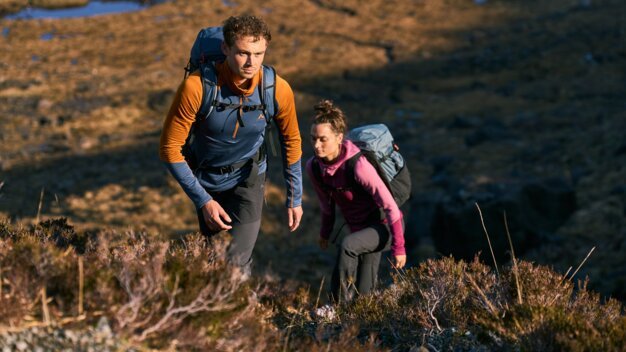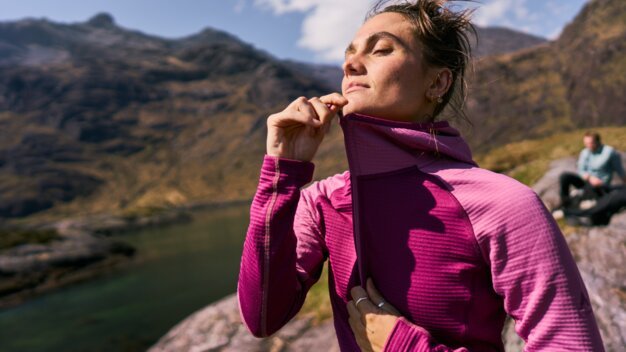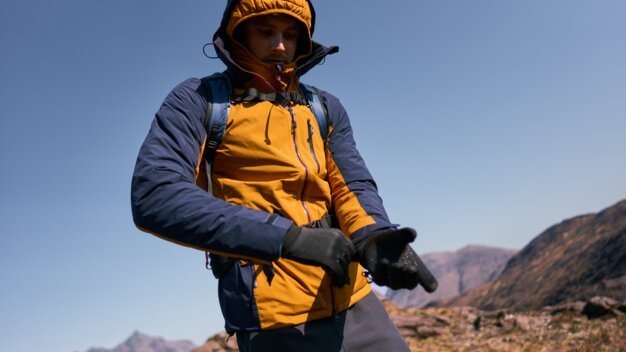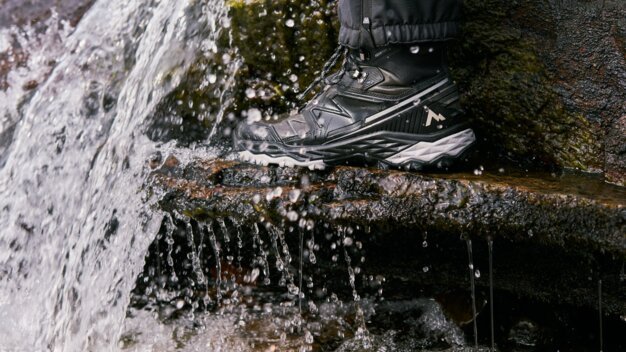
If you are planning your first trip, you want to avoid missing or even leaving behind important hiking essentials. Our RENTertainers have thought about this and have come up with a packing list that works for many hikes. We also answer questions on important topics such as layering, the right hiking boots and what to consider when packing your backpack.
Pay attention when choosing your hiking clothing
One of the most important factors to consider when packing your hiking essentials is the weather. Remember that the temperatures on the mountain are usually a few degrees colder than in the valley. In addition, you must always expect the weather to change quickly in the mountains.
When choosing your clothing, make sure that you wear breathable layers (base layer) of clothing on the way to the summit, but also have a mid-layer or an outer shell to hand. This will give you adequate protection against wind, rain and snow and prevent you from getting cold. Depending on the temperature, you can add or remove layers.
What is the onion principle and how does layering work?
The so-called onion principle (also known as layering) has become established in this context. This involves wearing functional layers of clothing on top of each other in such a way that they support your performance.
- The next-to-skin layer consists of breathable performance underwear (base layer) that quickly absorbs and wicks away moisture. It keeps skin dry and protects against chafing and chilling.
- The next layer is called the mid layer and ensures that body heat is retained.
- The hardshell or outer shell is designed to protect you from the elements such as rain, wind and snow. The membrane also supports breathability and transports moisture to the outside while preventing water from getting inside.
Tip: Pack your daypack so that you are prepared for any change in the weather.
Hiking essentials: checklist and equipment for all purposes
If you want to start hiking, the question of the right equipment is justified - after all, there is a lot of it. Our RENTertainers have put together the most important essentials for a day trip. But it's up to you to decide what you need on your tour.
Clothing and gear
- Hiking trousers
- T-shirt
- Mid layer
- An overcoat/rain jacket adapted to the weather conditions
- Hiking socks
- Drinking bottle
- Hiking boots
- Hiking poles
- Backpack
- Headband/headgear
Other hiking essentials
- Sunglasses
- Sunscreen and lip balm
- Cash
- Mobile phone
- Camera
- Personal medication
- Water and food
For emergencies
- First aid kit
- Bivouac sack
- Pocket knife
- Analogue card material
Choosing some good hiking shoes
Anyone who is in the process of putting together the perfect equipment for outdoor trips will inevitably face the question: Which hiking boots are the right ones?
As not every tour is the same and requirements vary, the selection is correspondingly diverse. From lightweight hiking boots to expedition boots, there are models that couldn't be more different.
What will my future hiking tours look like?
The better your idea of planned routes, the more precisely you can narrow down which shoe is right for you. The following criteria will help you to paint a picture of your hikes as concretely as possible:
- Duration
- Altitude metres
- Topography
- Surface
- Climate
- Weight of the hiking backpack
- Weather conditions
If you're struggling to choose your first pair of hiking boots, the INTERSPORT Rent outdoor experts at our more than 800 locations will be happy to help and advise you. In addition to the right model, they will also help you choose the right size and can give you good tips for trekking adventures in the surrounding area.
The right backpack for trekking and hiking
An often underestimated piece of equipment is the hiking backpack. It should offer enough space for all accessories and be comfortable at the same time, so it doesn’t get in the way during the hike.
A suitable carrying system is crucial for this. This should correspond to the length of the tour and the size of the pack. A wide hip belt ensures that the weight is evenly distributed over the hips, while a chest strap prevents the hiking pack from sticking out too far.
Depending on the manufacturer, backpacks for hiking have different systems that increase air circulation to prevent heat build-up on the back.
Which hiking essentials should not be missing on multi-day tours
If you are planning a multi-day tour, your equipment will be different. In addition to the existing gear, which will be supplemented by a change of clothing, you will have to decide whether you will cook for yourself during the trek or whether you will hike from hut to hut. The following list applies to both options:
- Tent
- Sleeping mat
- Cooker, crockery, cutlery
- Additional food
- Sleeping bag
- Hygiene articles (toothbrush, tooth cream, soap)
- Towel
All equipment listed is suggested and may vary depending on the trek. It is important to familiarise yourself with the tour so that you are prepared for all eventualities. Reports from other hikers on the internet can also help with planning. Popular platforms for tours often contain information on the equipment required.
Frequently asked questions about hiking essentials
What food should I take with me when hiking?
Make sure you always have enough food with you on your outdoor adventures. Nuts, dried fruit, but also sandwiches or sports bars are good snacks for in between. Make sure they are easily digestible foods that will provide you with energy for the hike.
What should be in a first aid kit when hiking?
A hiking first aid kit should contain the following items:
- Triangular scarf
- Sterile wound bandages in different sizes
- Rescue blanket
- Plasters in different sizes
- Scissors & tweezers
- Disposable gloves
The contents of your first aid kit may vary depending on the length and intensity of your hike.
What medications do I need for hiking?
First and foremost, you should take care of your personal needs. If you are dependent on medication, do not travel without it. This could include asthma inhalers or anti-allergy tablets. Mild painkillersor medicines for stomach aches and diarrheamay also be helpful. Often forgotten are sunscreen, lip balmand insect repellent.
INTERSPORT Rent Tip
The RENTertainer recommends
With shelves full of hiking gear, it can be hard to keep track of what you need. What do I need and what do I have to consider when choosing the right equipment? These are all questions our RENTertainers answer every day. They help you find out what really matters. From suitable shoes to gloves, sleeping mats and hiking poles, you'll find everything for your trip in our INTERSPORT Rent Shops. In addition to the right clothing, we also have useful gadgets for your outdoor adventures. Our experts will be happy to assist you and look forward to your visit.



